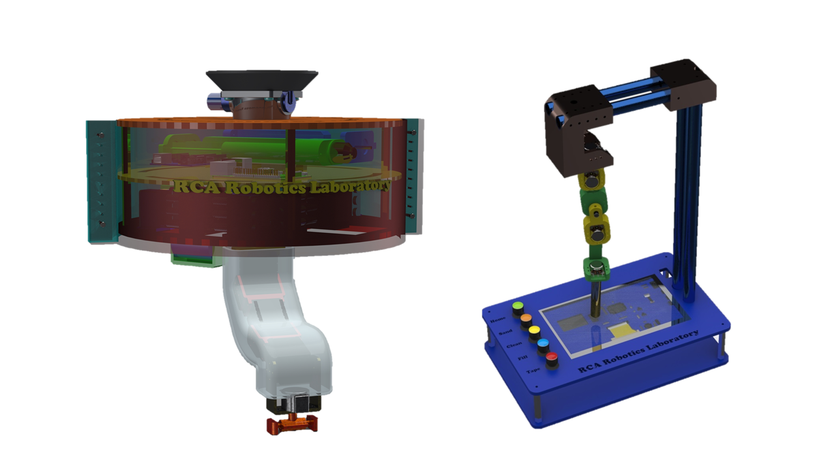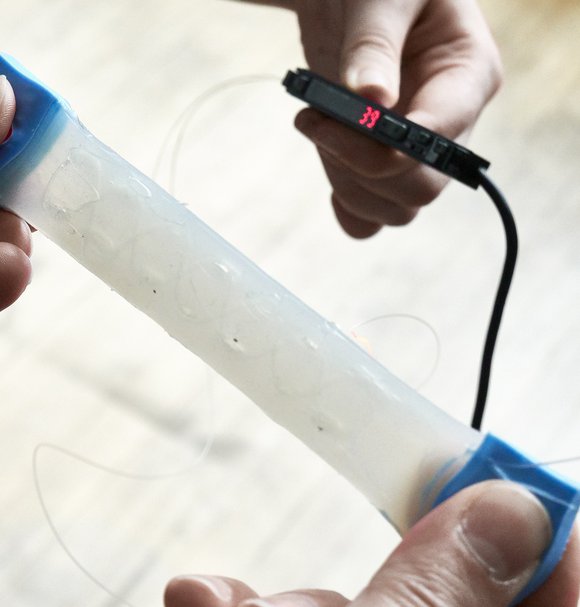Robot Mobility, Manipulation & Attachment
Jump to
Learning from nature, we develop technologies enhancing the ability of robots for mobility and manipulation in challenging environments.

Autonomous Repair Arm (left) and User Interface (right) for Infrastructure Maintenance and Repair
In particular, we are looking at enhancing the following performance measures:
- Versatility: To develop novel multi-modal mobility mechanisms for robots that can operate across a wide range of environmental conditions.
- Energy Efficiency: To Create smart robotic anchoring systems that can facilitate energy management in mobile robots.
- Safety & Durability: Tuning stiffness properties of robots to enabling (1) safer interaction with human and the environment, (2) make them more resilient to crushing forces, thereby more durable.
- Multi-Functionality: Modular design that enables quick switching between multiple functionalities whilst minimising the overall weight and size of the required hardware.
Bio-inspired Mobile Manipulation
Mobile Robotic Manipulators present a dual advantage of dexterity offered by a robotic manipulator and an unlimited workspace using a mobile platform. The design of these systems is predominantly inspired by complex mobility and manipulation abilities in biological organisms such as in octopus arm and elephant trunk. However, unlike the biological counterparts, they are typically comprised of heavy and rigid components that can damage the surrounding environment and human workers, limiting their application.
The emergence of soft composite materials, flexible electronics and advanced manufacturing technologies can enable development of a new generation of “soft mobile manipulators” that can adapt to various terrains in unstructured built heritage to safely navigate around and access hard-to-reach locations at height or inside confined spaces to perform monitoring or repair work which is the focus of our research. For examples of our practice in this area check out our work on the Autonomous Repair Arm with the MIMRee project.
Sensory-physical Anchoring Systems
A sensory-physical system is the integration of a physical process with sensors and computation enabling monitoring or the control of the process. A robotic anchoring module is a sensory-physical mechanism for attachment to the environment.
Robotic anchoring modules with the ability of maintaining their attachment for an extended time duration would be invaluable for a wide range of industrial and medical applications: attachment in climbing robots for inspection and cleaning of huge glass walls, nuclear plants and steel bridges, perching in flying robots that can provide a bird-eye view of an area of interest or object manipulation and attachment into delicate substrates, e.g. human body.
Selected publications
Bernardini, S., Jovan, F., Jiang, Z., Watson, S., Weightman, A., Moradi, P., Richardson, T., Sadeghian, R., Sareh, S. (2020) A Multi-Robot Platform for the Autonomous Operation and Maintenance of Offshore Wind Farms. In Proc. of AAMAS 2020, New Zealand, IFAAMAS, 5 pages.
Sareh, S., Althoefer, K., Li, M., Noh, Y., Tramacere, F., Sareh, P., Mazzolai, B., Kovac, M. (2017) Anchoring like octopus: biologically inspired soft artificial sucker, Journal of the Royal Society Interface, 14:135.
Y. Noh, J. Bimbo, S. Sareh et al., “Multi-axis force/torque sensor based on simply-supported beam and optoelectronics,” Sensors, vol. 16, no. 11, 2016.
Dams, B., Sareh, S., Zhang, K., Kovac, M., Ball, R. (2017) Aerial Additive Building Manufacturing: Three-dimensional Printing of Polymer Structures Using Drones. Proceeding of the Institution of Civil Engineers: Construction Materials.
Sareh, S., Siddall, R., Alhinai, T., Kovac, M. (2016) Bio-inspired soft aerial robots: adaptive morphology for high performance flight, In "Soft Robotics: Trends, Applications and Challenges", Volume 17 of the Series Biosystems & Biorobotics pp 65-74, Springer.
Sareh, S., Noh, Y., Li, M., Ranzani, T., Liu, H., Althoefer, K. (2015) Macro-bend optical sensing for pose measurement in soft robot arms, Smart Mater. Struct. 24 125024.
Sareh, S., Noh, Y., Ranzani, T., Liu, H., Althoefer, K., (2015) A 7.5mm Steiner chain fiber-optic system for multi-segment flex sensing, IEEE/RSJ International Conference on Intelligent Robots and Systems (IROS), 2336-2341.
Li, M., Ranzani,T., Sareh, S., Seneviratne, L.D, Dasgupta, P., Wurdemann, H., Althoefer, K. (2014) Multi-Fingered Haptic Palpation utilizing Granular Jamming Stiffness Feedback Actuators, Smart Mater. Struct. 23 095007.
Staff
Ask a question
Get in touch to find out more about our research spaces.
[email protected]



